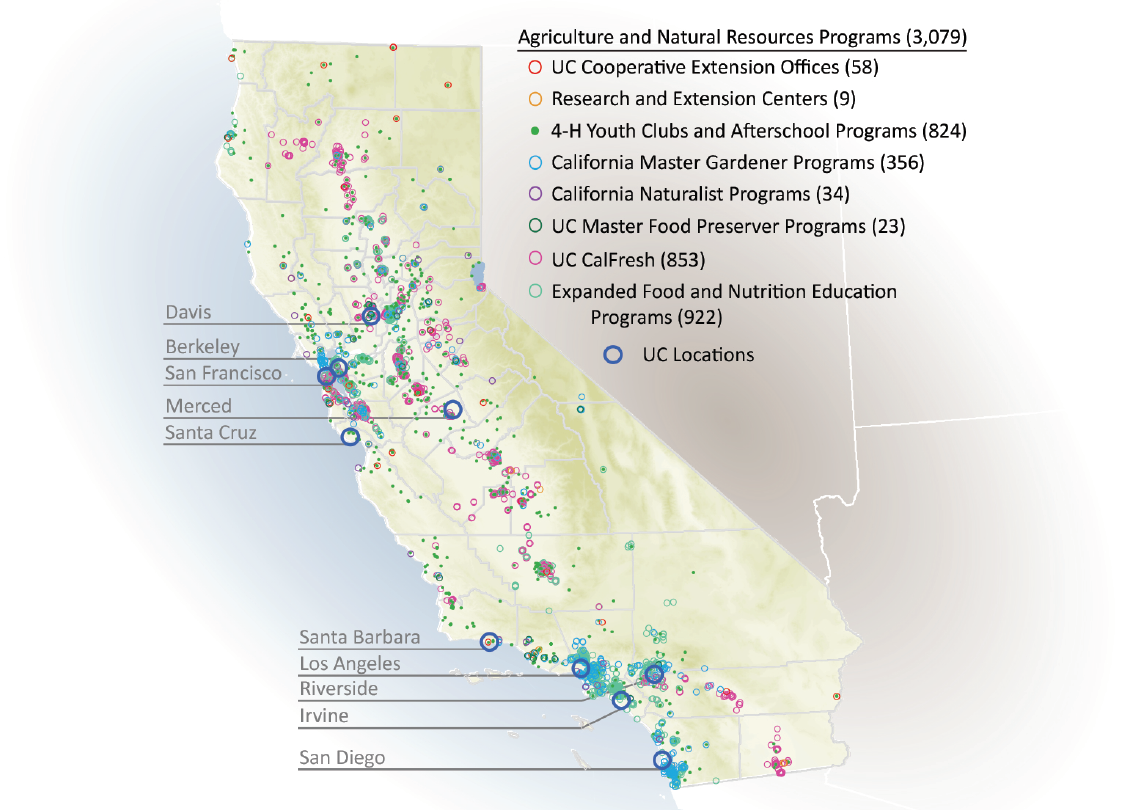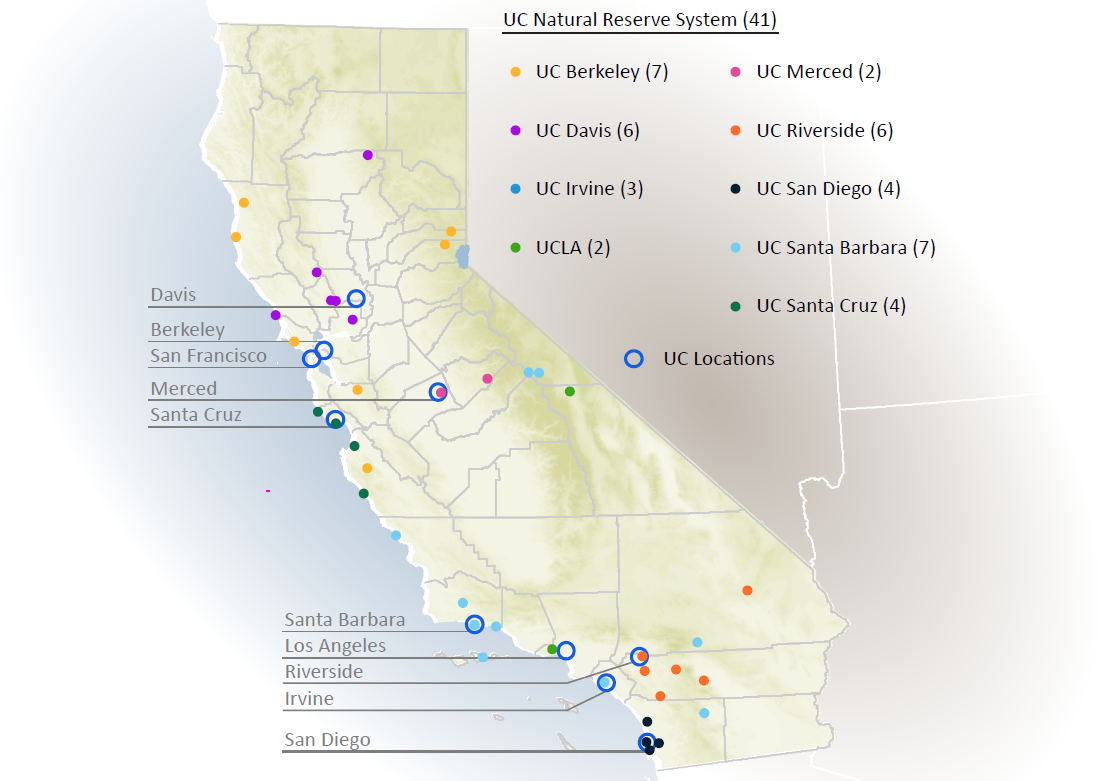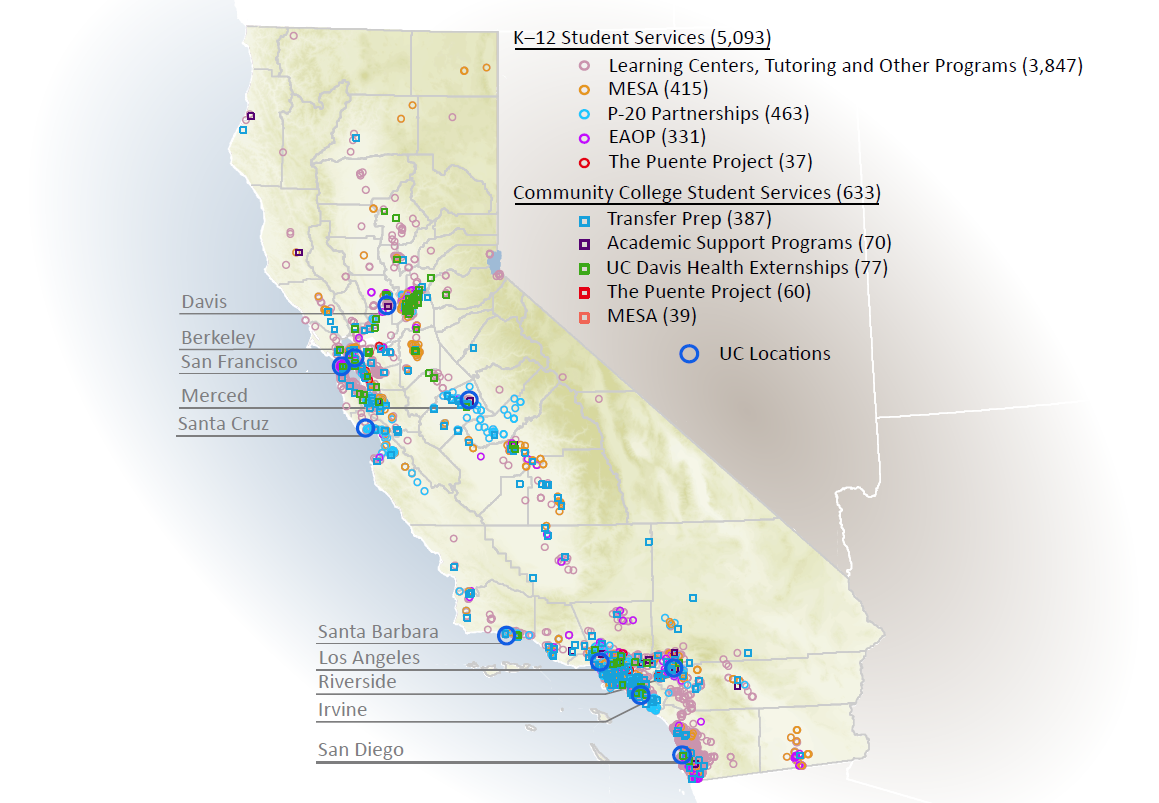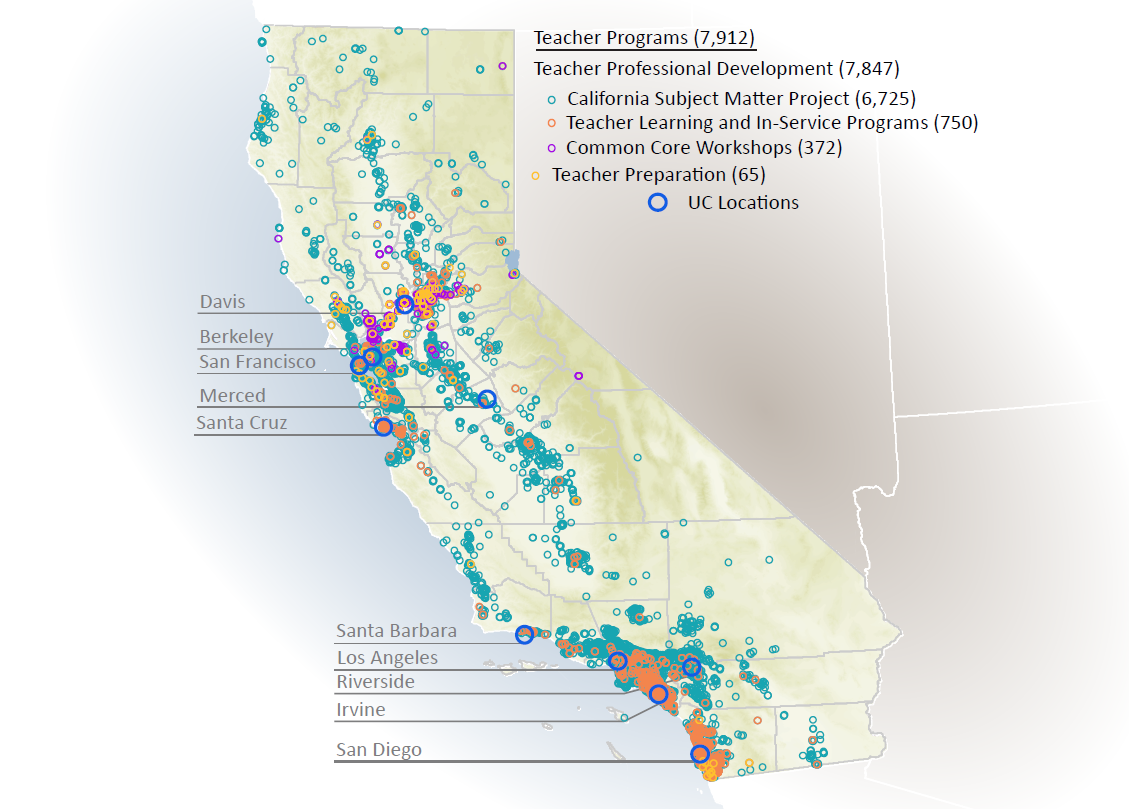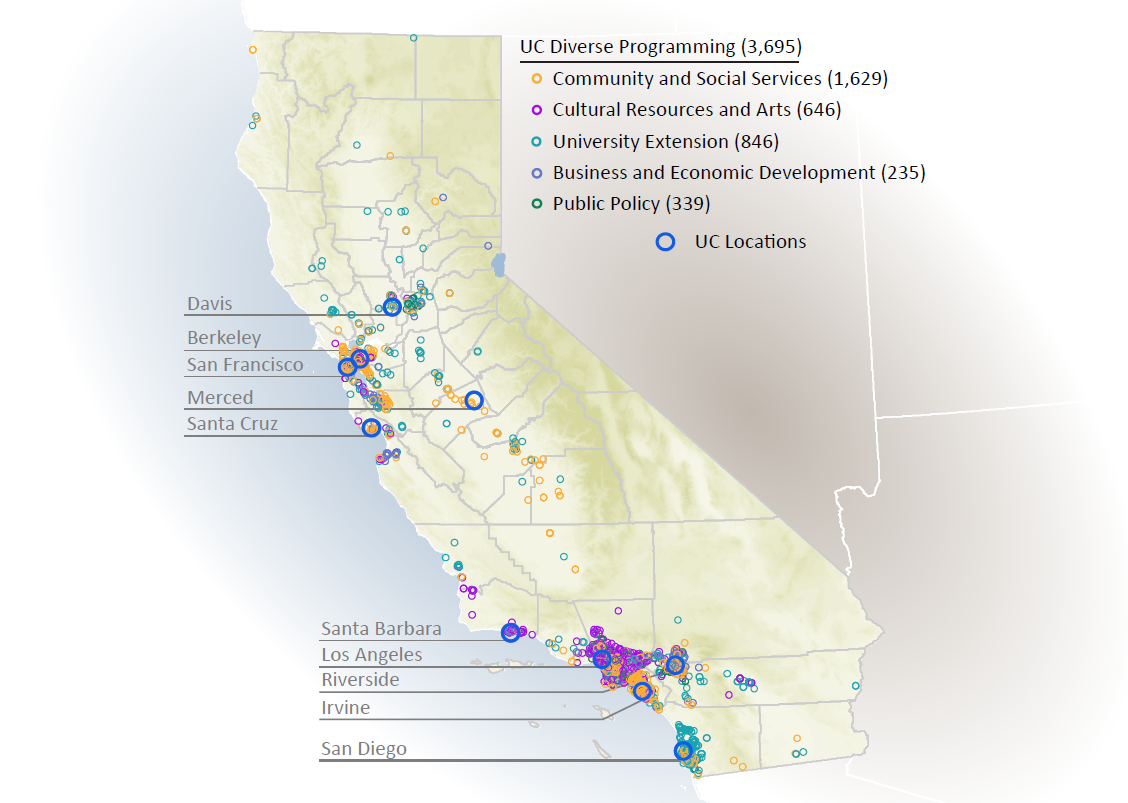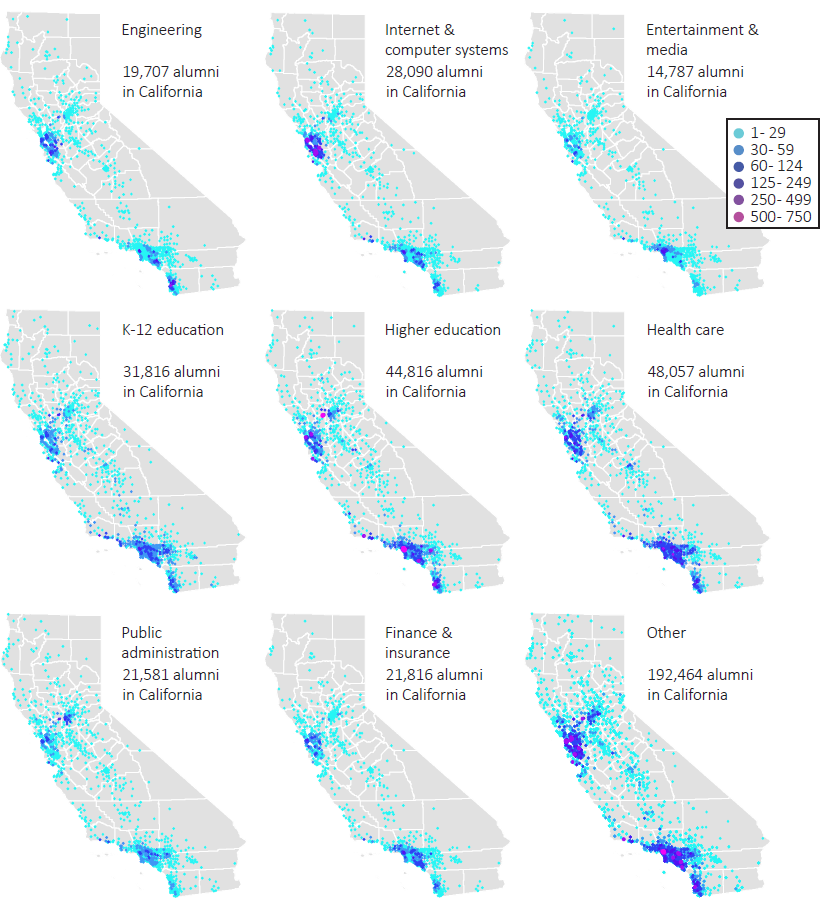Part of the UC mission
Along with teaching and research, UC contributes to the well-being of the state’s population and economic growth through its public service efforts. UC’s impact goes well beyond its on-campus activities. UC has a significant presence in nearly every community throughout California.
Educational outreach forms a crucial part of UC’s service to the state, including a network of world-class museums, libraries, herbaria, and other facilities open to the public for shared learning. Every UC campus administers hundreds or thousands of community-based programs across a range of foci, from community and social services to teacher professional development and K–12 student services.
The University exhibits a steadfast commitment to public service in part through support of sustainable agriculture, environmental stewardship, healthy families, and education. The Division of Agriculture and Natural Resources (ANR), the UC Natural Reserve System (NRS), the community-based programs of the Division of Diversity and Engagement, and all ten campuses are highlighted in this chapter.
UC Agriculture and Natural ResourcesUC’s land-grant historyThe Morrill Land-Grant Acts emphasized that the role of the University is to develop “useful and practical information … and to promote scientific investigations and experiments.” The Acts created a federal-state partnership for agricultural research and technology transfer. The University of California was chartered as California’s land-grant university. Subsequently, the Hatch Act of 1887 established state agricultural experiment stations. In 1914, the Smith-Lever Act established Cooperative Extension (CE) services to extend university research through outreach and education. UC’s Division of Agriculture and Natural Resources is UC’s land-grant arm. State legislation incorporated county governments to become the third legal partner, such that today, UC ANR represents a three-way partnership with federal, state, and county governments.
UC ANR personnel and programs deliver resources from the UC system to Californians — even if there is no campus nearby. UC ANR forms teams, across UC and beyond, to develop innovative, multidisciplinary, science-based solutions to complex issues. CE is also the education and outreach arm, serving all 58 California counties by bringing UC research to local communities. UC ANR’s mission is to engage UC with the people of California to achieve innovation in research and education that supports:
- Sustainable, safe, and nutritious food production and delivery
- Economic success in a global economy
- A sustainable, healthy, and productive environment
- Science literacy and youth development programs
UC ANR statewide network
UC ANR operates a statewide network of researchers and educators dedicated to the development and application of knowledge to address local agricultural, environmental, and health issues. This network of local Cooperative Extension (CE) sites and Research and Extension Centers (RECs) is often the face of the University to Californians to those with no other connection to the University. In 2019, 170 Cooperative Extension Advisors were conducting research, outreach, and education from local CE offices. Nine statewide RECs provide education for the public and places for researchers to conduct field experiments. Approximately 560 affiliated Agricultural Experiment Station (AES) researchers are located at three campuses, and 120 CE Specialists are located at five campuses, RECs, and county offices. UC ANR maintains and enhances connections that engage UC with the people of California through more than 3,000 local partnership programs (10.1.1).
In 2019, AES and CE published over 2,100 research-based, clientele-driven educational materials, and developed 24 patents. CE programs, including volunteers, had over 800,000 significant educational exchanges with adults and youth. CE educators and volunteers disseminated science-based information through over 41,000 community-based short courses, classes, workshops, demonstrations, and field days across the state. CE academics conducted over 800 media programs and interviews, further extending science-based information and solutions.
UC ANR also provided science-based information to policy and decision makers through 965 policy engagement activities. For example, three bills were informed by UC ANR academics’ work on prescribed fire in the northern part of the state. Signed into law in 2019:
- SB901, which includes $200 million per year for the next five years to fund forest health and fire prevention work, including prescribed fire;
- SB1260, which is focused primarily on prescribed fire and includes pieces on liability and training; and
- AB2091, which mandates the development of new insurance options for prescribed fire.
UC ANR’s statewide California Naturalist Program promotes stewardship of the state’s natural resources through education and service. The program develops the curriculum, trains partner organizations, and ensures quality through monitoring and evaluation. Since its inception in 2012, the program has worked with over 55 partner organizations and certified over 3,500 graduates as California Naturalists who volunteer in support of conservation and restoration efforts across the state. In 2019, the first bilingual and bicultural California Naturalist Certification Training course was developed. Twelve members of the Urban Conservation Corps of the Inland Empire members were trained. Their Los Naturalistas project has started changing the narrative in environmental education and interpretative services. There are now tours in Spanish with a Latino cultural twist, filling a void in the availability of environmental literacy services for the Spanish-speaking population of San Bernardino and Riverside Counties.
UC ANR’s UC Master Gardener Program extends to the public research-based information about food gardening and sustainable landscaping, including green waste reduction, pest management, water conservation, and pollinator-friendly gardens. There are over 5,900 UC Master Gardener volunteers in 50 California counties. In 2019, they donated close to 500,000 public service hours with an estimated value of $14.8 million. Participants reported adopting and improving gardening practices that protect natural resources and promote healthy people and communities on over 1.3 million square feet of home, school, and community gardens.
UC ANR’s statewide 4-H Youth Development Program uses a positive youth development framework and promotes experiential, inquiry-based science learning. In 2019 the program engaged over 155,000 youth aged 5-19 to help them reach their full potential, through working in partnership with over 14,500 caring adult volunteers. The annual statewide evaluation uses common measures; for example, in 2019, 96 percent of 800 4-H youth respondents reported they feel a responsibility to help their community, and 73 percent of 707 youth respondents in grades 8 to 12 reported aspirations such as studying science after high school.
UC ANR manages two statewide nutrition education programs: the California Expanded Food and Nutrition Program (EFNEP) in 24 counties, and the CalFresh Healthy Living, University of California (CFHL,UC) Program in 31 counties. EFNEP delivers research-based nutrition education to limited-resource families with young children to improve healthy lifestyle choices. In 2019, EFNEP reached almost 41,000 adult and youth family members. Evaluations of adult participants indicate 95 percent improved at least one diet quality practice, and 83 percent improved one or more skills for food safety. CFHL,UC operates under a joint agreement involving the USDA, California Department of Social Services, and UC Cooperative Extension to serve persons eligible for the federal Supplemental Nutrition Assistance Program. In 2019, in-person education was provided to over 97,000 participants. Furthermore, CFHL,UC policy, systems, and environmental interventions (e.g., smarter lunchrooms that influence healthy choices, food-based gardening, quality physical activity, wellness policies) were adopted by 397 partner sites, indirectly reaching over 176,000 individuals in early childhood centers, schools, and community environments.
The scope of UC ANR impact
UC ANR continues to focus on making a difference with regard to seven public values, listed below. Participant behavior change outcomes are measured, and research shows how these contribute to longer-term social/health, environmental, and economic benefits. Selected 2019 indicators follow.
Promoting economic prosperity — UC ANR research and extension helps growers change practices that increase their economic return, and individuals and families improve financial management practices. For example, one program focused on small farm business management workshops in the Sierra Foothills. From surveys over the last five years, improved farm business planning has had significant impacts on small farm and ranch profitability. Over 86 percent of business operators who participated reported being profitable and paying themselves a salary. Such outcomes contribute to increased agricultural profitability.
Safeguarding abundant and healthy food for all — UC ANR creates practical solutions and informs policy, leading to changes in practices from food production to food security. For example, UC ANR academics collaborated on evaluating the Mandela Health and Wealth Net project funded by the Centers for Disease Control and Prevention. The project seeks to increase access to affordable fresh fruits and vegetables and economic resilience in low-income communities in Alameda County by establishing a network of locally-owned food retailers, farms, and distributors. Residents increased pounds of fruits and vegetables per transaction by 122 percent (from 0.9 to 2.1 pounds) at corner stores and 250 percent (from 2.8 to 9.9 pounds) at produce stands, demonstrating how the project increased access and improved fruit and vegetable purchasing in low-income communities.
Protecting California’s natural resources — Through UC ANR research, outreach, and education, participants learn about and adopt recommended practices that improve ecological sustainability. For example, UC ANR best management practices for spraying broad-spectrum pesticides is becoming more commonplace in almond orchards around California. As a result, growers can avoid almost 500 pounds of formulated pesticide loss into the atmosphere per spray application, contributing to improved air quality.
Building climate-resilient communities and ecosystems — UC ANR conducts research and delivers programs to assist farmers and ranchers in implementing climate-smart management practices, to reduce greenhouse gas emissions in working landscapes, and to expand public awareness of effective adaptation strategies. For example, a UC ANR scientist engaged with 200 community members and policy-makers in the North Coast region, with the result that participants reported they had a better understanding of regional vulnerabilities to climate change (90 percent) and strategies for local climate action (77 percent). Through education, communities become more climate-resilient.
Promoting healthy people and communities — UC ANR produces tools, programs, and policy-relevant research that result in healthy living for individuals and communities. For example, the Nutrition Policy Institute conducted a longitudinal study that was the first to present findings to policymakers about the potential benefits of extending the age of eligibility for benefits under the Special Supplemental Nutrition Program for Women, Infants, and Children (WIC) until children are eligible for school meals. In this way, UC ANR contributes to improving individual health for all.
Developing a qualified workforce for California — UC ANR’s youth and community development programs equip the next generation for college, for successful careers, and to be active participants in their communities. For example, 88 percent of 508 4-H youth respondents reported social and leadership skills, including the ability to communicate through multiple methods and value and respect for other cultures. This demonstrates skills learned related to college and careers, which are the pathway to entering the workforce.
Developing an inclusive and equitable society — UC ANR engages people across communities to build skills and develop proactive policies to increase cultural competency and diversity in California’s workplaces. For example, one program focuses on culturally responsive research and extension to limited-resource Asian farmers in the San Francisco Bay Area. As a result, the State Water Resources Control Board adopted language in the revisions to the Eastern San Joaquin River Watershed Agricultural Order to allow alternate reporting requirements for diversified, small-scale, and socially disadvantaged farmers. These changes are precedential for the state and can benefit similar farmers in other counties.
UC Natural Reserve SysteM
The UC Natural Reserve System (NRS) is a network of protected natural areas throughout California. These lands are managed for research, teaching, and public service, and are a major component of UC’s environmental stewardship. Its 41 reserves, covering more than 756,000 acres, make it the largest university-administered reserve system in the world (10.2.1).
As one of four trustee agencies recognized under the California Environmental Quality Act, the University of California holds reserve natural resources in trust for the people of the State of California. Reserve managers protect endangered plants and animals, restore native habitats, and control invasive species. Reserves also serve the public by holding lecture series, guided hikes, and other community events; by lending scientific expertise to conservation initiatives; and by hosting tens of thousands of California schoolchildren on field trips.
Most major state ecosystems are represented in the NRS, from coastal tidepools to inland deserts, oak savannas to offshore islands, and wetlands to Sierra Nevada forests. Reserves also serve as gateways to more than one million acres of public lands. NRS reserves include lands purchased by the University, donated by private landowners, and made available to the reserve system via partnerships with state and national parks, land trusts, and government agencies. Reserve amenities such as classrooms, lodging, laboratories, and internet access attract tens of thousands of users each year. These include researchers, students taking university courses, schoolchildren, and the general public. Those who seek to understand the workings of natural California come to the NRS to take classes, develop field skills, and conduct research.
More than 150 undergraduate courses across the UC system include visits to NRS reserves each year. Topics of study range from botany to zoology, archaeology to environmental planning, public health to the performing and visual arts. Scientists flock to reserves because reserve lands are protected in perpetuity. They feel comfortable launching long-term studies within reserve boundaries. Work at reserves produced more than 2,900 peer-reviewed papers, book chapters, and books between 2010 and 2018.
In 2019, Point Reyes Field Station and Lassen Field Station joined the NRS as partnership reserves, which are jointly managed with the National Park Service at Point Reyes National Seashore and Lassen Volcanic National Park, respectively.
More than fifty years after its inception, the need for the NRS has never been greater. Climate change, pollution, extinctions, and invasive species are fraying the fabric upon which life on Earth depends. By supporting university-level teaching, research and public service, the NRS contributes to the understanding and wise stewardship of the Earth.
Educational partnerships
For nearly 50 years, the University of California’s Student Academic Preparation and Educational Partnerships (SAPEP) programs have helped prepare California students for higher education (10.3.1). Program activities are centered on student academic preparation, community college articulation support, school and community partnerships, and online and technology-assisted services. SAPEP programs served more than 210,000 K–12 students at more than 1,400 public schools and more than 28,000 students at all 114 California community colleges in 2018–19.
The goal is to promote achievement by supporting academic preparation and college readiness. Programs include the Early Academic Outreach Program (EAOP), which focuses on “a–g” course completion (a prerequisite for admission to UC and CSU); K–20 Regional Intersegmental Alliances (aka P–20), creating ties between campuses, schools, local communities, and business organizations; The Puente Project, focusing on college-preparatory English skill development; Transfer Prep, focusing on community college transfer support; and Mathematics, Engineering, Science Achievement (MESA), focusing on STEM (science, technology, engineering, and mathematics) skills development.
The Mathematics, Engineering, Science Achievement (MESA) program integrates UC’s core missions of teaching and public service by focusing on the academic preparation of students at K–12 schools, community colleges, and four-year universities. Through its three components — the MESA College Prep Program (formerly known as MESA Schools Program or MSP), the MESA Community College Program (MCCP), and the MESA University Program (formerly known as MESA Engineering Program or MEP) — MESA serves more than 21,000 California students annually.
MESA College Prep centers are housed in 18 locations and serve more than 14,000 students at about 350 K–12 schools. Centers offer classes that reinforce math and science content standards. MESA activities include workshops aimed at strengthening study skills and monitoring progress.
The MESA Community College Program (MCCP) manages 40 centers at community colleges, serving around 4,000 students annually. These centers provide academic excellence workshops, orientation courses, academic advising, and counseling activities to help community college students transfer to a four-year university in a timely manner.
The MESA University Program operates 13 centers located in public (UC and CSU) and private universities across the state. Serving about 3,000 students annually, these centers assist college students in attaining four-year degrees in engineering and computer science by providing tutoring and academic skills workshops. In partnership with local industry leaders, MESA University Program centers also provide career and professional development opportunities for students. In addition to the activities UC undertakes to strengthen K–12 and community college students academically, UC plays an important role in preparing California’s teacher workforce. UC’s Teacher Education Programs prepare teacher candidates to engage students in rigorous, relevant, and inquiry-based educational experiences. Located at eight UC campuses, Teacher Education Programs recruit, prepare, and support educators who are committed to academic excellence, equity, and integrity, and to cultivating the highest levels of achievement and opportunity for all students.
UC also provides ongoing support to educators already in the workforce through professional development programs. For example, the California Subject Matter Project (CSMP) is a network of nine discipline-based statewide projects, providing more than 2,000 professional development events for educators at more than 10,000 schools each year. CSMP professional learning opportunities are aligned with state-adopted standards and are collaboratively designed by K–12 and university educators to enhance learning for all students (10.3.2).
Social and economic impact
Including the programs of ANR, the Natural Reserve System, and UC’s educational partnerships mentioned above, the University of California administers more than 20,000 community-based programs across the state. Because the well-being of every California citizen and community is important, all campuses sponsor and manage programs far from their locations. For example, UC San Diego, near the southern border of California, runs clinical internship sites in Crescent City and other communities near the northern border of California; UC Davis, in the Central Valley, runs the Oiled Wildlife Care Network in Morro Beach on the central coast; and UC Santa Barbara, on the California Coast, runs the Outdoor Science Education Program in several locations on the east side of the Sierra Nevada range. All of UC’s community-based programs may be discovered and explored here,
UC’s social impact
Through community and social services programs and cultural resources and arts programs, UC administers internship and field study programs that connect students and alumni with their communities; volunteer centers working on issues such as domestic violence, fair housing advocacy, and employment training; arts education and outreach programs that teach art, dance, drama, music, and digital arts in the community (10.4.1).
UC’s economic impact
Through business and economic development programs and public policy programs, UC facilitates internships offered in partnership with local companies, where students gain both UC credits and professional experience. Other programs bring local high-tech and green-tech companies together with motivated individuals to foster student participation in community economic development (10.4.1).
As California’s economy becomes increasingly dependent on highly educated workers, the role of the University of California in training the state’s future workforce becomes more vital. Industries relying on skilled workers in the STEM fields represent a major component of California’s economy. UC awards half of the state’s bachelor’s degrees in STEM fields.
More than 1.2 million UC alumni are known to live and work in California (10.4.2). They are leaders, volunteers, and contributors to the vitality of its communities, businesses, and culture. UC’s operations also add significantly to the state’s economy. With approximately 210,000 employees, UC is California’s third-largest employer (10.4.3). True to its land-grant mission, the UC system touches many aspects of life in California. The UC public service mission has evolved in tandem with the changing needs of our state and local communities, and has developed programs and partnerships that improve the lives of all Californians.
For more information
